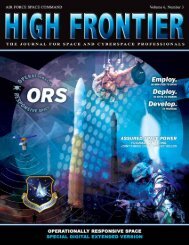Space Acquisition - Air Force Space Command
Space Acquisition - Air Force Space Command
Space Acquisition - Air Force Space Command
Create successful ePaper yourself
Turn your PDF publications into a flip-book with our unique Google optimized e-Paper software.
on the ground” in the contractor’s facility and “face-to-face”<br />
time with the users on a regular basis is vital to understanding<br />
what is really going on; these give another perspective to the<br />
facts provided in earned value management system reports and<br />
program management reviews.<br />
Author James D. Rendleman: I worked on a program where<br />
the prime contractor demanded the government deliver a very<br />
specific space shuttle launch window for its payload. This presumed<br />
launch window did not match any calculations made by<br />
NASA’s engineers and its vast array of computer-based mission<br />
planning resources. The dispute festered until one day, while<br />
walking through the contractor’s facility, the government mission<br />
design lead saw a globe with a string hanging from its<br />
North Pole. He asked, “What’s the string used for” “To calculate<br />
the launch window requirements.” This is a rather sad,<br />
but true story.<br />
Value brilliance no matter how it is packaged. Select excellence<br />
always.<br />
Rendleman: I have seen contractor managers thrown out of<br />
meetings by NASA because they didn’t know their systems;<br />
interestingly, in a moment that demonstrated excellence really<br />
mattered, the same Texas-bred, blue-jeaned NASA engineer<br />
managers then insisted on only talking to the contractor’s<br />
uniquely flamboyant software engineer, because that engineer<br />
really understood the system. Refreshing!<br />
Give team members authority and power and then hold them<br />
accountable. Ensure individuals are accountable, not committees;<br />
you cannot hold committees accountable. Proper alignment<br />
of authority, power, and accountability are essential and<br />
must apply to everyone at all levels. Numerous texts and studies<br />
point out that authority, power, and accountability must be<br />
consistent. The problems created by TSPR that were described<br />
previously are a classic example of how improper alignment of<br />
authority, power, and accountability can cause programmatic<br />
failures; under TSPR, US <strong>Air</strong> <strong>Force</strong> program managers had no<br />
authority to resolve the problems they faced.<br />
1b. Organize to be lean and mean.<br />
Keep management teams small and focused; always be prepared<br />
to optimize team staff and organization as the program<br />
evolves. This approach reflects the best sentiments of Battle’s<br />
Laws and philosophy.<br />
Today, this approach is in practice at the mission control<br />
stations for DigitalGlobe® and GeoEye®, 17 in small payloads<br />
at the University of Colorado, and in operations at the US <strong>Air</strong><br />
<strong>Force</strong> Reserve 6 th <strong>Space</strong> Operations Squadron—the backup for<br />
the National Oceanic and Atmospheric Administration’s Defense<br />
Metrological Satellite Program. The APL is flying a mission<br />
to Pluto and another to Mercury out of the same mission<br />
control center—which, based on the physical space, the JPL or<br />
Johnson <strong>Space</strong> Center would consider a conference room. The<br />
footprint of the 45 th <strong>Space</strong> Wing and <strong>Space</strong> and Missile Systems<br />
Center military launch combined task force has been dramatically<br />
reduced, as the business case for United Launch Alliance<br />
activities bears out. 18 In terms of acquisitions, this approach is<br />
successfully employed in payloads that are being developed by<br />
the Defense Advanced Research Projects Agency and the <strong>Air</strong><br />
<strong>Force</strong> Research Laboratory.<br />
Also, use committees and integrated process teams (IPTs)<br />
judiciously. If you form one, it should have a specific purpose<br />
and be disbanded when its purpose is fulfilled. Committees do<br />
not make decisions and the staff and lawyers only tell you what<br />
you already know or cannot use—so minimize the use of committees<br />
to that which is necessary. You still need individuals<br />
who you can hold responsible.<br />
Rendleman: Once, while visiting former Deputy Secretary of<br />
Defense Gordon England in his office, while he was executive<br />
vice president of General Dynamics, I asked him where his staff<br />
was. He replied, “I don’t need a staff. I hire people who know<br />
their business. Staff will only tell me things I already know.”<br />
England was part of a management team that helped General<br />
Dynamics restructure and become more efficient.<br />
IPTs have a place and are valuable when used properly. Do<br />
not let IPTs (or committees) take on “a life of their own.” Some<br />
programs get hopelessly bogged down in committee meetings<br />
and management reviews, expending hour upon hour of the<br />
government and contractor teams’ time in preparing for, attending,<br />
and debriefing meetings. Team optimization might entail<br />
eliminating IPTs (or their equivalents) if they are not as effective<br />
as they were in an earlier stage of the program. Alternatively,<br />
it might be better to streamline IPTs and/or shift resources<br />
among IPTs for greater effectiveness.<br />
1c. Build and maintain healthy, open, professional relationships<br />
with team members, counterparts, and contractors.<br />
Rely strongly on the recommendations of your team members,<br />
but make sure they give problems sufficient consideration.<br />
Make sure their decision loops are short; they have solid,<br />
agreed-to definitions of their authorities and accountabilities;<br />
and that they understand the processes for making decisions.<br />
Taverney: While commander of <strong>Space</strong> Launch and Range, I<br />
was fortunate to have previously-developed relationships and<br />
friendships within each of the launch contractors. When I<br />
would hear about a problem, I was never shy about calling the<br />
contractor’s expert in-the-know to get the on-the-ground truth.<br />
Contractors do not usually try to hide anything from you; but<br />
when a problem surfaces, it may be hard at first to determine<br />
what precisely has occurred—as the communications may come<br />
through various paths and may be filtered by a variety of people.<br />
Putting your feet in your contractor’s or user’s facility is also<br />
a great way for creating and nurturing working relationships.<br />
As the authors moved up in the ranks, the relationships they<br />
built while working at contractors’ facilities later gave them direct<br />
communication channels they could rely on to ascertain<br />
what was really going on. 19<br />
Enhance communication with your industry counterparts<br />
with consistent, frequent personal contact. This is critical to<br />
success in all businesses. The authors have met successful<br />
managers and leaders in various industries and it was clear that<br />
their success was invariably tied to personal partnering with<br />
customers, team members, and suppliers. One cannot foster<br />
solid relationships by reading status reports or other documents<br />
of success or failure.<br />
57 High Frontier











